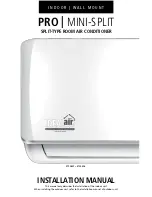
13
A. Hot gas is discharged from the compressor. The temperature of the gas is monitored by the Discharge
Temperature sensor and sent to the outdoor control panel.
B. The hot gas is directed through the 4-way valve, then enters the outdoor coil. The hot gas will be slightly
subcooled, however there are no pressure ports to take measurements.
C. The subcooled liquid will enter the filter to remove contaminates.
D. The subcooled liquid will enter the Electronic Expansion Valve (EEV) and will regulate to about a 10 degree
superheat level. The EEV will adjust its flow based upon the temperature
sensor readings. The adjustment process and compressor speed are controlled by the outdoor circuit board.
E. The refrigerant leaving the EEV will be in a low pressure/temperature saturated state. This cold saturated
refrigerant will move through the coil absorbing heat. This liquid will flash to a vapor and will be superheated
to about 10 degrees F. Since this tubing is cold, it must be insulated.
F. The superheated vapor will be returned to the outdoor unit’s 4-way valve.
G. The refrigerant will flow to the accumulator (not all models will have an accumulator) where liquid and vapor
are separated.
H. The refrigerant will flow to the compressor and complete another refrigeration cycle.
The control board will monitor the temperature and pressures and adjust the frequency of the compressor and
flow rate of the EEV as needed. There are no pressure charts to evaluate temperature or pressures.
Product Introduction
Cooling Mode














































